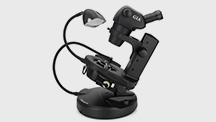Jadeite Market Update
Jeff Mason
President, Mason-Kay, Inc.
Interview with Jeff Mason, President, Mason-Kay, Inc.President, Mason-Kay, Inc.
More than 95 percent of Mason-Kay’s market is in the US. Asian jade-quality preferences are somewhat different from those of American consumers. In general, Asians value translucency over color, while Americans value color over translucency. There’s also a difference in carving-design preferences. Mason-Kay accommodates this difference by “Americanizing” Asian designs.
Mr. Mason has seen an increase in demand for and prices of jade jewelry, especially in the past year or two. He declares that a key to encouraging this increase is education. People’s lack of knowledge leads to fear about prices, qualities, and treatment issues. Mason-Kay reduces those anxieties by educating their clients and ensuring the integrity of their product.
In a discussion about treatments, Mr. Mason states that treated jade is nothing new—jade has been dyed to enhance its color for many decades. A newer treatment, polymer impregnation, has been in use for about three decades, but requires expensive laboratory equipment for detection that the average gemologist can’t justify owning.
In one segment, Mr. Mason discusses the effects of the US embargo against Burmese jade, which started in 2008 and continues to this day. They’ve been forced to buy domestically ever since. Fortunately, the company had stockpiled jadeite supplies before that in anticipation of the ban. Also, in the same year the ban took effect, the world economy experienced a downturn. Despite its overall negative effect, this had two positive effects on Mason-Kay: They didn’t sell out their stockpiled inventories as quickly and they were often able to buy out other companies’ goods at distressed prices.
In these interviews, Jeff Mason provides us with a fascinating look into a sometimes-misunderstood gem and its often-unpredictable market.



